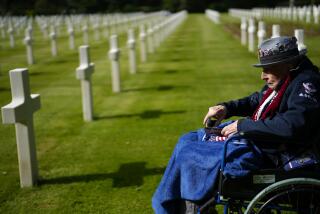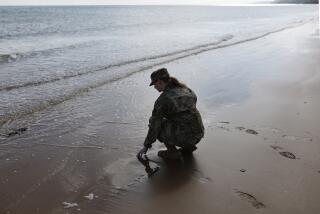‘Go-for-Broke’ Veterans Put It on the Line Once More
The most highly decorated Army unit in World War II is on another mission.
But rather than carrying bayonets and bullets, and rather than fighting in Europe, the soldiers are now using words as weapons and the new battlefield is the United States.
Many have forgotten that the most decorated Army unit was made up of Japanese-Americans. Those men, now in their 60s and 70s, are fighting to remind the world of their exploits, and to prevent their children and grandchildren from having to prove their loyalty to this country, as they had to do in the 1940s after Japan attacked Pearl Harbor.
“Our mission today is to get our story retold,” said George Nishinaka, 62, president of the Veterans Assn. of the 100/442nd Regimental Combat Team. “We only have 10 or 15 more years left, and then none of us will be around anymore. The association won’t be around, because we’ll all be dead. We don’t want our children and our grandchildren, or the rest of the world, to forget what we fought for.
“We are starting to see some negative things relative to Asians in this country,” Nishinaka said, noting the imbalance of trade with Japan and a growing anti-Japanese sentiment, particularly among displaced auto workers. “There shouldn’t be any of this nonsense going on. We want to make sure we didn’t fight that war for nothing.”
As part of that effort to retell their story and fight discrimination, members of the 100/442nd RCT will ride on old World War II vehicles Saturday in Torrance’s 27th Annual Armed Forces Day Parade, the largest civilian-sponsored armed forces parade in the country.
Torrance Councilman George Nakano, a third-generation Japanese-American who spent time as a child in three different internment camps during the war, said he invited the veterans of the 100/442nd RCT to participate in the parade to remind the South Bay, where about 100 veterans of the 100/442nd RCT live, of the “tremendous contributions and sacrifices they made.”
“I am proud of their accomplishments,” said Nakano, Torrance’s first councilman of Japanese descent.
“In a parade like this, the general public will be reminded that there was such a unit,” said Young Kim, 68, of Gardena, a career military man of Korean descent who served as a captain in the 100/442nd RCT, and was a colonel when he retired from the service 14 years ago. “We could be role models, not just for the Japanese-Americans, but for all Asians.”
The roots of the 100/442nd RCT began in 1942 shortly after Executive Order 9066 was issued forcing the relocation of more than 110,000 West Coast residents of Japanese descent to 10 detention camps scattered throughout the country. The war hysteria created a fear that the Japanese-Americans would be loyal to Japan, and rumors of espionage and sabotage were rampant.
About 3,500 Japanese-Americans already serving in the armed forces were disarmed and reassigned to menials jobs. Other Japanese-Americans, who had registered for the draft since 1940, were reclassified 4-C, unfit to join the Army.
Residents of Hawaii, about a third of whom were of Japanese descent and where no Japanese-Americans were incarcerated, complained and asked that a Japanese-American infantry unit be formed to prove their loyalty.
The unit was formed with about 1,300 men, and after training in Mississippi and Louisiana, the men were designated as the 100th Infantry Battalion.
Pleased with the success of the 100th Battalion, the Army in February, 1943, ordered the formation of a volunteer all-nisei, or second-generation Japanese-Americans, combat unit.
More than 3,000 men from Hawaii and more than 1,500 from the internment camps volunteered to form the 442nd Regimental Combat Team.
“It was put-up-or-shut-up time,” said Hiroshi Takusagawa, 63, of Gardena. Takusagawa was in an internment camp in Gila River, Ariz., when he volunteered.
“We had been saying that we were as American as anyone else and now we had to prove it.”
Shipped to Oran
The 100th Infantry Battalion, meanwhile, was sent to Oran, North Africa. But when they got there they were assigned to guard supply trains running between Casablanca and Tunisia.
“Our battalion commander protested, saying that we didn’t come all this way to guard a train. We came here to fight,” recalled Young Kim.
A battalion assigned to Italy was reassigned and the 100th was quickly sent in to replace it. They joined the 34th Division and stormed the beaches of Salerno. The unit saw action in Montemarano, Volturno, Cassino and, finally, captured the beachhead at Anzio.
The 100th Battalion was then attached to the 442nd RCT in Italy as the first of three battalions on the team.
The first group in the 100/442nd RCT adopted a shoulder patch depicting an arm holding the torch of liberty. They also adopted the phrase “Go for Broke,” used by gamblers when their entire stake rides on one bet, as their battle cry.
Seven Campaigns
The 100/442nd was involved in seven major campaigns, including the liberation of Bruyeres, France, in October, 1944, and, later that month, in the rescue of the “Lost Battalion,” the all-Texan 2nd Battalion, 141st Regiment, 36th Division, that had been surrounded for a week by German troops in southern France.
The 100/442nd suffered 800 casualties, including 200 who were killed, to save 275 men. A total of 650 men of the 100/442nd were killed in action during the two years they were involved in the war.
In all, the 100/442nd RCT received 18,143 individual decorations of valor, including a Medal of Honor--the highest award in the military service--52 Distinguished Service Crosses, 7 Presidential Unit Citations, 588 Silver Stars and 9,486 Purple Hearts.
According to the Congressional Record, the 100/442nd RCT is the most decorated unit of its size and length of service in the history of the United States.
The veterans of the 100/442nd RCT have only recently begun getting involved in community and public affairs because now many of them are retired or about to retire.
Reestablished Community
“The bulk of our energy for the past 40 years has been trying to reestablish our community,” Kim said. “The average soldier came back from war and he had to go to a camp to pick up his parents and, maybe, his girlfriend in what was still a hostile environment, and tried to start his life over again from scratch.
“For many of the older people, the camp experience was very shattering. They were broken psychologically, they were broken emotionally. They became like handicapped people, and became an additional burden for the returning soldier.”
But while their war effort has made life easier for their children and grandchildren, that freedom has gone unappreciated and resulted in condemnation for allowing the internment to have ever taken place.
“Only now that the third generation is old enough to reflect do they understand what the first and second generations have done,” Kim said. “For the longest time we were condemned for not fighting the incarceration.
‘Not Like a TV Movie’
“But I don’t think people understand what it means when a soldier has a loaded gun, and you’ve got nothing, and he tells you to move. It’s not like a TV movie where you go disarm the guy.
“There was a great gap there because the average third and fourth generations were so Americanized that they couldn’t understand not standing up for your rights. They are only now beginning to understand the conditions under which we existed.
“But that’s what we fought for, even though sometimes your own children condemn you.”
The 100/442nd CRT Veterans Assn. has joined in the fight for an apology and compensation from the federal government for the nearly 60,000 surviving people who had been interned.
“If the government arrested you falsely and put you in prison, what’s the only recourse that the government can do?” asked Nishinaka, the association’s president. “It can’t give you back the time. The only way the government can redress is to make a token monetary payment.”
Other Projects
The veterans as a group and as individuals are also working on other projects to perpetuate their memory.
Kim and several other veterans have joined a national effort to establish a Japanese-American National Museum in downtown Los Angeles’ Little Tokyo. Last year they were successful in getting $750,000 from the state and $1 million from the Los Angeles Community Redevelopment Agency for the project.
Last week, the Los Angeles City Council directed the city Department of General Services to draw up a 50-year lease for the museum to use the city-owned Nishi Hongwanji Buddhist Temple in Little Tokyo to house a permanent collection chronicling the history of Japanese-Americans.
“We need another $10 million, but we hope to open the doors in about two years,” said Y. B. (Buddy) Mamiya, 69, a Torrance veteran of the 100/442nd RCT whose father fought in World War I.
Takusagawa is involved in Go For Broke Inc., a San Francisco-based nonprofit organization involved in creating a national monument to the Japanese-American veterans and which serves as a clearing house for Japanese-American veteran affairs.
Traveling Exhibit
He said the group has had a traveling exhibit of Japanese-American involvement in World War II tour the country, as well as in Paris and Japan. He said the group most recently was involved in getting a permanent exhibit in a new wing of the Smithsonian Institution in Washington. The exhibit will open in September, 1987.
While efforts to memorialize the efforts of the 100/442nd are under way, Takusagawa said that convincing third- and fourth-generation Japanese-Americans to get involved in their effort may be more difficult.
But, he said, their children will be a living remembrance of their fight for equality.
“People say we have to get our sons and daughters involved, but that’s a pipe dream,” Takusagawa said. “My son tells me, ‘That was your bag.’ But he also says that if you taught us to be better Americans, then that is a better monument than sticking a flag somewhere.
“He’s right. All we’ve ever wanted is for people to know that we are Americans first and foremost, and nothing else.”
More to Read
Sign up for Essential California
The most important California stories and recommendations in your inbox every morning.
You may occasionally receive promotional content from the Los Angeles Times.










